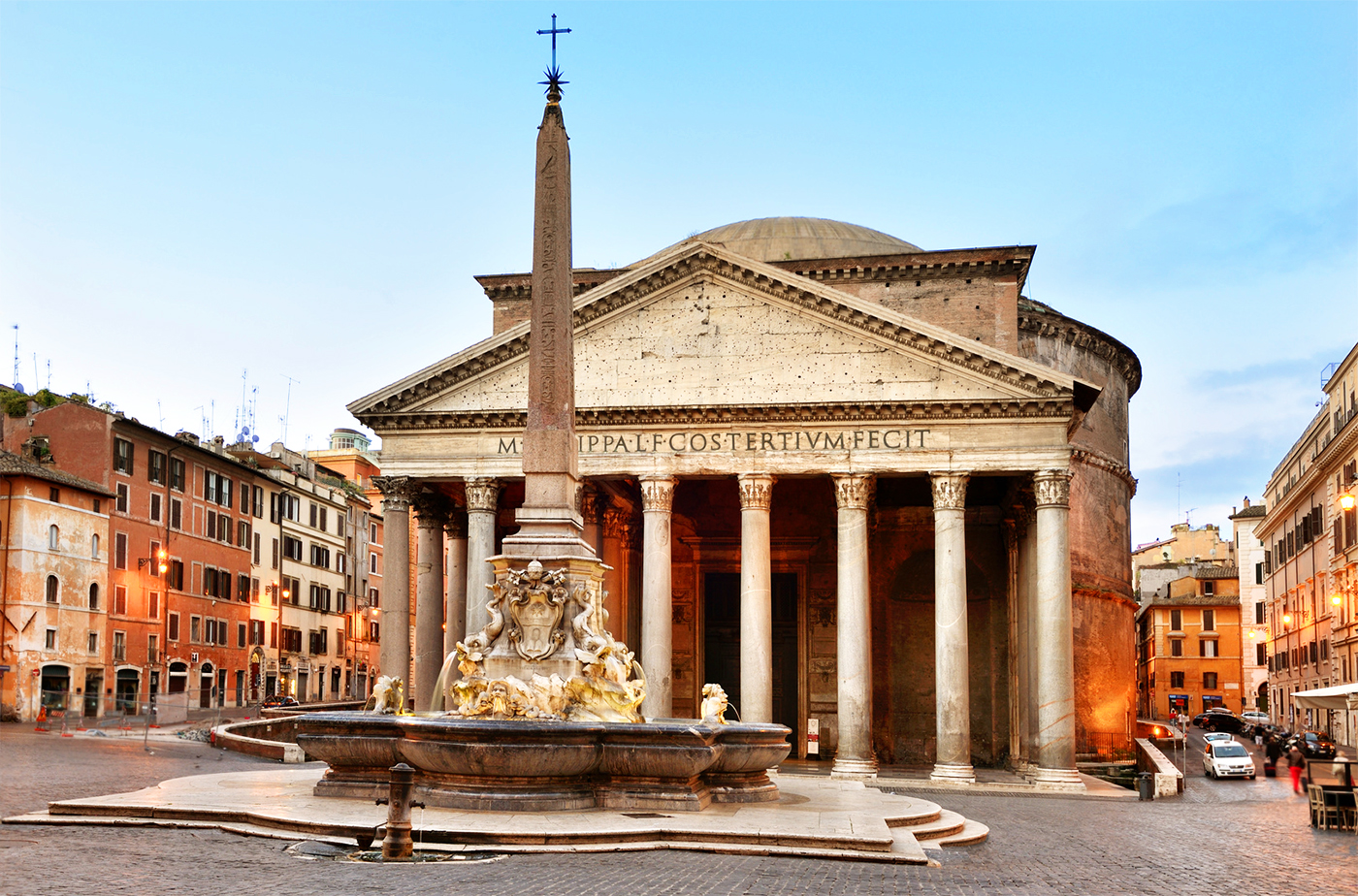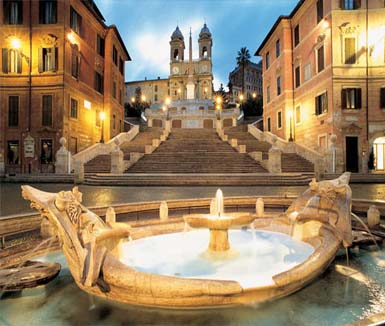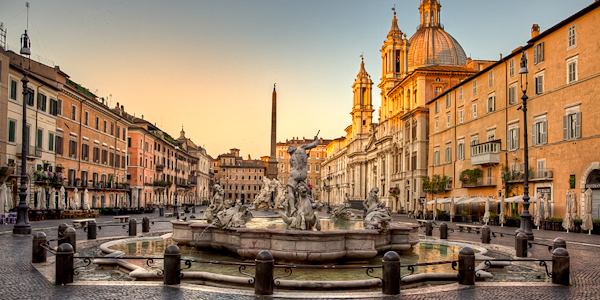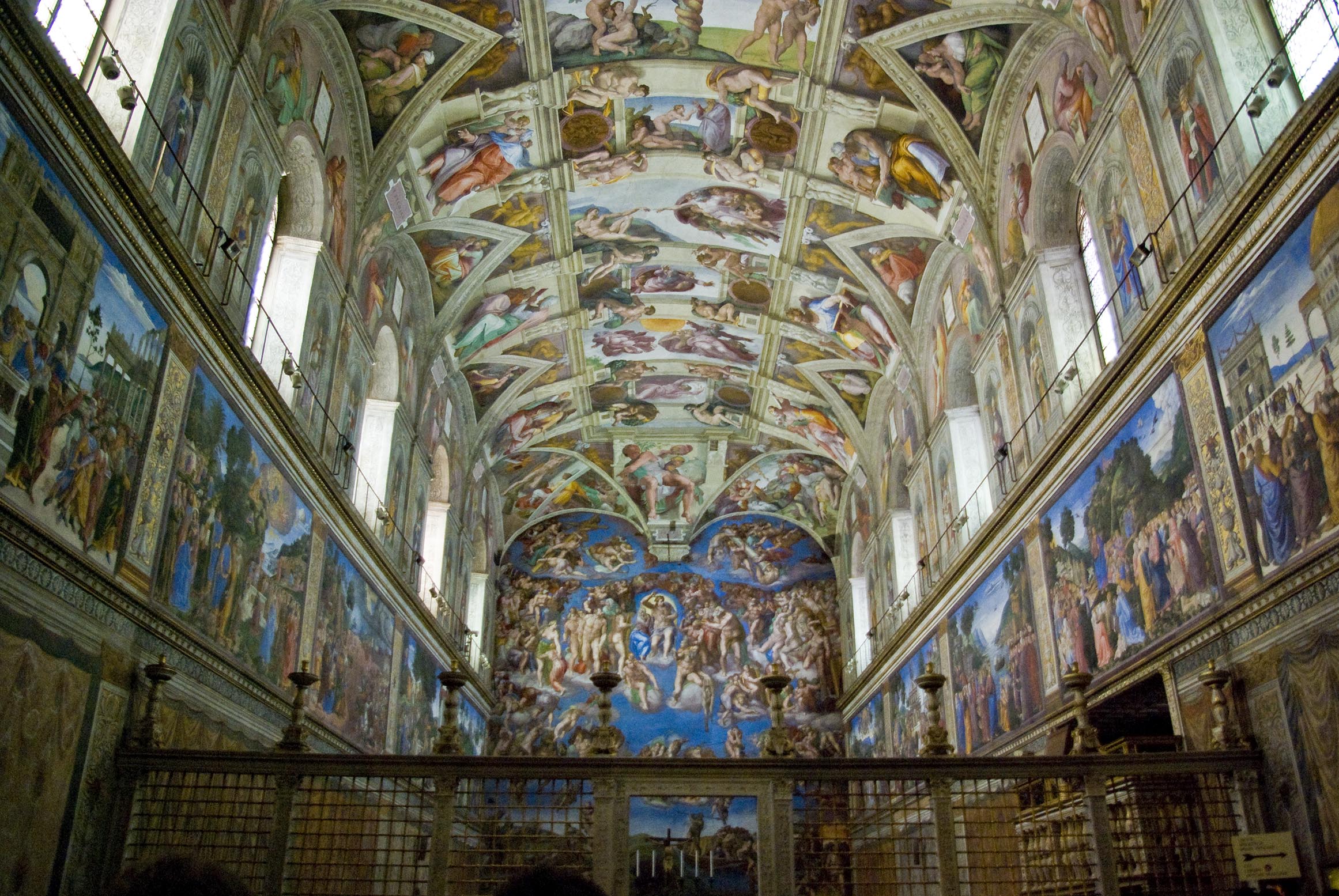Classical Rome
The Colosseum: http://www.coopculture.it/colosseo-e-shop.cfm
The Colosseum is the biggest amphitheatre in the world, is located right in the center of Rome, between the Celio area and the very neighboring Imperial Fora and Venice square. Inside, the Colosseum had seating for more than 50,000 spectators. The distinctive exterior had three stories of arched entrances–a total of around 80–supported by semi-circular columns. Each story contained columns of a different order (or style): At the bottom,there were columns of the relatively simple Doric order, followed by Ionic and topped by the ornate Corinthian order. Located just near the main entrance to the Colosseum was the Arch of Constantine, built in A.D. 315 in honor of Constantine I’s victory over Maxentius at Pons Milvius."As long as the Colosseum stands, so shall Rome, when the Colosseum falls, Rome shall fall; so falls the world."

The Roman Pantheon is the most preserved and influential building of ancient Rome. It is a Roman temple dedicated to all the gods of pagan Rome. As the brick stamps on the side of the building reveal it was built and dedicated between A.D 118 and 125.
The emperor Hadrian (A.D 117-138) built the Pantheon to replace Augustus’ friend and Commander Marcus Agrippa’s Pantheon of 27 B.C
Probably one of the most fascinating features of the Pantheon is its Architecture. The structure of the Pantheon is comprised of a series of intersecting arches. The Roman Pantheon was probably constructed by using an elaborate setup of wooden scaffolding. The most fascinating part of the Pantheon is its giant dome, with its famous hole in the top (The eye of the Pantheon, or oculus). The dome was the largest in the world for 1300 years and until today it remains the largest unsupported dome in the world! The diameter of the dome is 43.30 meters or 142ft (for comparison, the United States Capitol dome is 96 feet in diameter) and is in perfect proportion with the Pantheon by the fact that the distance from the floor to the top of the dome is exactly equal to its diameter.
The detail of this building is extraordinary.When approaching the Pantheon from the outside it appears rectangular in shape. But it is only the first small room (cella) that has corners. The rotunda is completely round. The small entry room would have been entered by climbing a staircase that is now entirely under modern ground level.In front of the Pantheon is the beautiful “Fountain of the Pantheon”. It was designed by famous architecture Giacomo Della Porta in 1575 and sculpted out of marble by Leonardo Sormani. In 1711, Pope Clement XI requested that the fountain be modified and had FilippoBarignoni design a new layout, which included a different basin, made of stone, and the obelisk of Ramses II set in the centre on a plinth with four dolphins decorating the base.

Capitoline Museums: http://www.museicapitolini.org/
The creation of the Capitoline Museums has been traced to 1471, the world's oldest public museums. when Pope Sixtus IV donated a group of bronze statues of great symbolic value to the People of Rome. The collections are closely linked to the city of Rome, and most of the exhibits come from the city itself.Their collection of classical sculpture is one of Italy's finest, including crowd-pleasers such as the iconic Lupacapitolina (Capitoline Wolf), a sculpture of Romulus and Remus under a wolf, and the Galatamorente (Dying Gaul), a moving depiction of a dying Gaul warrior. There's also a formidable picture gallery with masterpieces by the likes of Titian, Tintoretto, Rubens and Caravaggio.The statue of a mounted rider in the centre of the piazza is of Emperor Marcus Aurelius. It is a copy, the original being housed on-site in the Capitoline museum. The museums' entrance is in Palazzo deiConservatori
The Capitoline Museums are composed of three main buildings surrounding the Piazza del Campidoglio and interlinked by an underground gallery beneath the piazza.
.JPG/373px-0_Lupa_Capitolina_(2).JPG)
Baroque Rome
Spanish steps: http://www.turismoroma.it/?lang=enThe Spanish Steps are a set of steps in Rome, climbing a steep slope between the Piazza di Spagna at the base and Piazza Trinità dei Monti, dominated by the Trinità dei Monti church at the top. The steps are also one of the longest and widest staircases in all of Europe. The steps are linking the lower Piazza di Spagna with the upper Piazza Trinità dei Monti and its magnificent church.
The monumental stairway of 135 steps was built with French diplomat Étienne Gueffier’s bequeathed funds of 20,000 scudi, in 1723–1725, Monti church that was under the patronage of the to the Holy See in Palazzo Monaldeschi located below. The stairway was designed by architects Francesco de Sanctis and Alessandro Specchi.
In the Piazza di Spagna at the base is the Early Baroque fountain called Fontana della Barcaccia ("Fountain of the ugly Boat"), built in 1627–29 and often credited to Pietro Bernini, father of a more famous son, Gian Lorenzo Bernini, who is recently said to have collaborated on the decoration. The elder Bernini had been the pope's architect for the Acqua Vergine, since 1623. According to a legend, Pope Urban VIII had the fountain installed after he had been impressed by a boat brought here by a flood of the Tiber river.

Trevi fountain: http://www.trevifountain.net/
The Trevi Fountain was built in the 15th century to mark the ending destination of the Aqua Virgo, the manmade channel erected in 19 B.C. that brought fresh water to Roman bathhouses. The design of the trevi fountain is based on three architectural elements: a façade Travertine; statues of Carrara marble; a see reef also made of travertine.
In the middle there is the statue of Ocean. In the left part of the arch there is the statue of Abundance holding the horn of plenty.In the right portion there is the statue of Health.

Navona square: http://stadiodomiziano.com/
The site for today’s square is built on the ancient Stadium of Domitian. The stadium was also known as “Circus Agonalis” – “the competition arena”. Piazza Navona is one of Rome’s most beautiful squares. It houses several Baroque masterpieces. The square is dominated by three large fountains, which together with a church and its harmonious surroundings, creates an enchanting and vibrant oasis in the heart of Rome.
The central fountain is known as “Fontana dei Quattro Fiumi”, meaning “the fountain of the four rivers”. This beautiful fountain was constructed in mid 17th century on request of the pope and created by the famous Italian artist Bernini.
The fountain is based around four figures. Not surprisingly - when considering its name - these figures are meant to honor four major rivers from different continents. The rivers are; the Nile, Ganges, Danube and Rio della Plata.
The fountain to the south is known as Fontana del Moro – the Moor fountain. It is centered around a large statue designed by Bernini, depicting a Moor holding a large fish. This statue was added in the 17th century while the surrounding tritons are 19th century additions.
The fountain to the north is called Fontana di Nettuno – the Neptune fountain. It was originally built in late 16th century. The fountain is dominated by a statue of Neptune fighting an octopus, surrounded by several statues depicting sea nymphs.
The church of Sant’Agnese in Agone which looks onto Piazza Navona, was originally the chapel of the Pamphili family, who lived in the building next door. The interior is rich in statues, gilded stucco, frescoes, and marble altarpieces, all are works of Bernini's pupils.

Contemporary Rome
The Galleria Nazionale d’Arte Moderna e Contemporane, most popularly known simply as GNAM, was founded in 1883. At first, it was located at the Palazzo delle Esposizioni (Palace of Expositions). Later on it was moved to its current location at Villa Borghese. This building was designed by architect Cesare Bazzani. The artworks inside the museum are exhibited in 75 halls. Over 5,000 paintings and sculptures are housed inside this grand contemporary building. Among the collections include the works of the famous Vincent Van Gogh, Piet Mondrian, Claude Monet and Charles Simon Catel, among others.The works featured inside the GNAM range from abstracts to conceptual to realistic impressionist. One moment you will be overwhelmed by the gigantic images of Roman gods, and another moment you will be amazed by a cloth that has been plastered with wimps!
In addition to their permanent in-house collections, the GNAM features exhibitions from different artists such as Andy Warhol. This makes the museum dynamic and at the same time traditional.

MAXXI museum: http://www.fondazionemaxxi.it/
The National Museum of XXI century Arts, is the first Italian national institution devoted to contemporary creativity. The programming of the activities- exhibitions, workshops, conferences, shows, projections, educational projects- reflects MAXXI’s vocation as a place for the conservation and exhibition of its collections but also, a laboratory for cultural experimentation and innovation, for the study, research and production of our time.
http://en.museiincomuneroma.it/ne_fanno_parte/macro
The MACRO - Rome's Museum of Contemporary Art - came into existence due to the reorganisation of the structures on the Capitoline devoted to the promotion of contemporary art. It is spread over two sites. The first is the old Peroni factory, which, until 1971, was in active production for the Peroni Beer Society . It was designed at the beginning of the twentieth century by Gustavo Giovannoni and is one of the few examples of industrial archaeology in the capital.
The first phase of the reconstruction and conversion of the site finished in 1999. It involved the recovery of the main building, which is composed of two parallel factory units, connected by a construction which corresponds to the front facade. The work was finished as part of Odile Decq's Sensual Territories project, following an international competition held by the Municipality of Rome in 2000.
The other site is split across two pavilions in the building complex of the old slaughterhouse in Testaccio, which was built between 1888 and 1891 to a design by the architect Gioacchino Erosch.
The first phase of the reconstruction and conversion of the site finished in 1999. It involved the recovery of the main building, which is composed of two parallel factory units, connected by a construction which corresponds to the front facade. The work was finished as part of Odile Decq's Sensual Territories project, following an international competition held by the Municipality of Rome in 2000.
The other site is split across two pavilions in the building complex of the old slaughterhouse in Testaccio, which was built between 1888 and 1891 to a design by the architect Gioacchino Erosch.

Vatican city:
The Vatican Museums are the museums of the Vatican City and are located within the city's boundaries.The idea of creating the Vatican Museums came about at the beginning of the 16th century by pope Julius II (1503-1513), and had important classical statues such as the Apollo and the Laocoon transferred to the Vatican and placed in the Belvedere Palace garden.The Pius-Clementine Museum takes its name from two Popes: Clement XIV, (1769-1774) its founder, and Pius VI (1775-1799), who brought it to completion. The museum has three main collections of ancient works of art: the statuary and portraits, the works with funerary connotation and the mosaics. . Some notable galleries are:
· Octagonal courtyard
· Gallery of the Statues
· Gallery of the Busts
· Cabinet of the Masks
· Sala delle Muse
· Sala degli Animali
· Greek Cross Gallery
The New Wing, Braccio Nuovo built by Raffaele Stern, houses important statues like The Prima Porta Augustus, Doryphorus, and The River Nile. Galeria Lapidaria is another part of Chiaramonti museum, with more than 3,000 stone tablets and inscriptions, which is the world's greatest collection of its kind.
The Museums also include the Gallery of Tapestries, a collection of various 15th and 17th century tapestries; the Gallery of Maps, decorated under the pontificate of Gregory XIII (1572-1585) and restored by Urban VIII (1623-1644); the Sobieski Room and the Room of the Immaculate Conception; the Raphael Stanze and the Loggia, which were decorated by order of Julius II and Leo X (1513-1521); the Chapel of Nicholas V (1447-1455), painted by Fra Angelico; the Sistine Chapel, which takes the name of its founder, Pope Sixtus IV; the Borgia Apartment, where Pope Alexander VI lived until his death (1492-1503); the Vatican Pinacoteca, created under Pius XI (1922-1932) in a special building near the new entrance to the Museums; the Missionary-Ethnological Museumwhich was founded by Pius XI in 1926, arranged on the upper floors of the Lateran Palace and later transferred, under Pope John XXIII, to the Vatican where it has been opened again to the public in the same building which housed the former Lateran collections. In 1973 the Collection of Modern and Contemporary Religious Art was added and inaugurated by Pope Paul VI (1963-1978) in the Borgia Apartment. The Vatican Historical Museum, founded in 1973 and transferred in 1987 to the Papal Apartment in the Lateran Palace, houses a series of papal portraits along with objects of the past Pontifical Military Corps and of the Pontifical Chapel and Family and historic ceremonial objects no longer in use. The Carriage and Automobile Museum is a section of the Vatican Historical Museum. In the year 2000, the Vatican Museums opened a new large entrance that provides visitor information and other services; on display are many new artworks, two of which were specially created for this grand entrance hall.
The Museums also include the Gallery of Tapestries, a collection of various 15th and 17th century tapestries; the Gallery of Maps, decorated under the pontificate of Gregory XIII (1572-1585) and restored by Urban VIII (1623-1644); the Sobieski Room and the Room of the Immaculate Conception; the Raphael Stanze and the Loggia, which were decorated by order of Julius II and Leo X (1513-1521); the Chapel of Nicholas V (1447-1455), painted by Fra Angelico; the Sistine Chapel, which takes the name of its founder, Pope Sixtus IV; the Borgia Apartment, where Pope Alexander VI lived until his death (1492-1503); the Vatican Pinacoteca, created under Pius XI (1922-1932) in a special building near the new entrance to the Museums; the Missionary-Ethnological Museumwhich was founded by Pius XI in 1926, arranged on the upper floors of the Lateran Palace and later transferred, under Pope John XXIII, to the Vatican where it has been opened again to the public in the same building which housed the former Lateran collections. In 1973 the Collection of Modern and Contemporary Religious Art was added and inaugurated by Pope Paul VI (1963-1978) in the Borgia Apartment. The Vatican Historical Museum, founded in 1973 and transferred in 1987 to the Papal Apartment in the Lateran Palace, houses a series of papal portraits along with objects of the past Pontifical Military Corps and of the Pontifical Chapel and Family and historic ceremonial objects no longer in use. The Carriage and Automobile Museum is a section of the Vatican Historical Museum. In the year 2000, the Vatican Museums opened a new large entrance that provides visitor information and other services; on display are many new artworks, two of which were specially created for this grand entrance hall.


Saint Peter’s Basilica: The church is built on Vatican Hill, across the Tiber river from the historic center of Rome. The location is highly symbolic: this was the site where Saint Peter, the chief apostle, died a martyr and where he was buried in 64 AD. St. Peter is considered the first pope, so it made perfect sense for the papacy to build the principal shrine of the Catholic church here.
In the early fourth century Emperor Constantine, the first Christian emperor of Rome, decided to build a basilica on Vatican Hill at the site of small shrine that marked the likely location of the tomb of St. Peter. Construction of the basilica started between 319 and 322. It was consecrated in 326 AD and finally completed around 349 AD.
St. Peter's Square
Visitors on their way to the St. Peter's Basilica pass along St. Peter's Square, a grandiose elliptical esplanade created in the mid seventeenth century by Gian Lorenzo Bernini. The square is bordered by massive colonnades that symbolize outstretched arms. Bernini and his assistants sculpted the 140 statues of saints that grace the balustrades on the colonnades. The square is decorated with fountains and an Egyptian obelisk that was transported to Rome in 37 AD. The view of St. Peter's Basilica from the square is unfortunately a bit disappointing; the result of the enlargement of the church carried out by Carlo Maderno, which partly obscures Michelangelo's dome.
The largest church in the world, it has a 211.5 meter long nave (694 ft, including the narthex). The basilica's dome is one of the world's largest measuring 42 meters in diameter and reaching 132.5 meters high (more than 434ft).
http://www.vatican.va/various/basiliche/san_pietro/index_it.htm
In the early fourth century Emperor Constantine, the first Christian emperor of Rome, decided to build a basilica on Vatican Hill at the site of small shrine that marked the likely location of the tomb of St. Peter. Construction of the basilica started between 319 and 322. It was consecrated in 326 AD and finally completed around 349 AD.
St. Peter's Square
Visitors on their way to the St. Peter's Basilica pass along St. Peter's Square, a grandiose elliptical esplanade created in the mid seventeenth century by Gian Lorenzo Bernini. The square is bordered by massive colonnades that symbolize outstretched arms. Bernini and his assistants sculpted the 140 statues of saints that grace the balustrades on the colonnades. The square is decorated with fountains and an Egyptian obelisk that was transported to Rome in 37 AD. The view of St. Peter's Basilica from the square is unfortunately a bit disappointing; the result of the enlargement of the church carried out by Carlo Maderno, which partly obscures Michelangelo's dome.
The largest church in the world, it has a 211.5 meter long nave (694 ft, including the narthex). The basilica's dome is one of the world's largest measuring 42 meters in diameter and reaching 132.5 meters high (more than 434ft).
http://www.vatican.va/various/basiliche/san_pietro/index_it.htm


